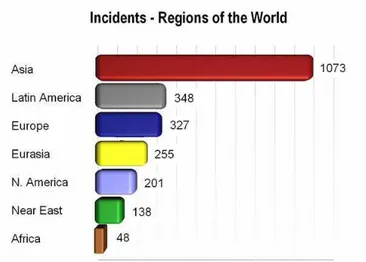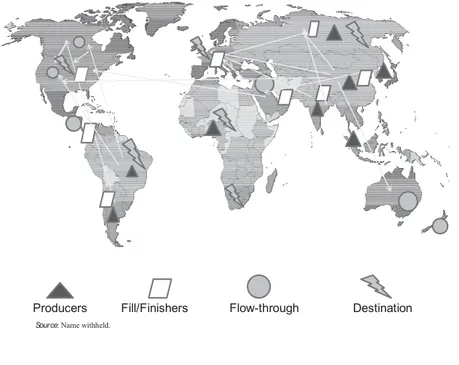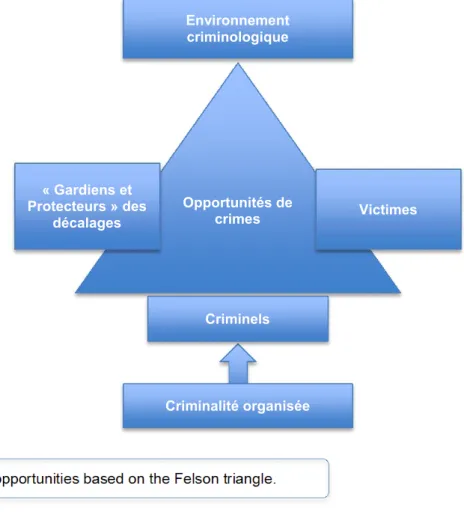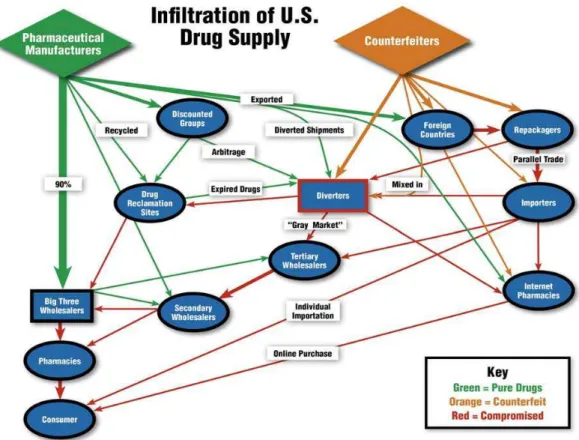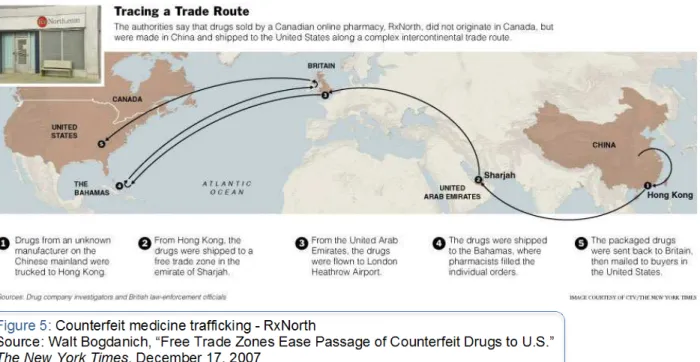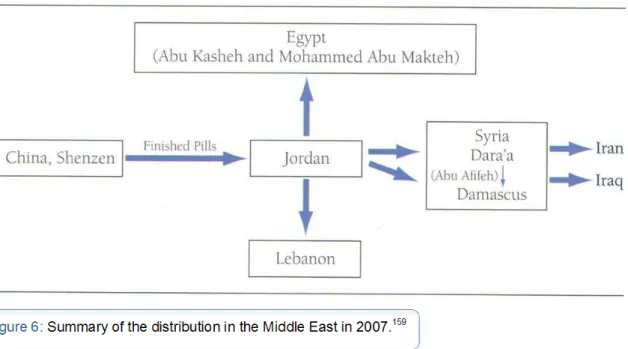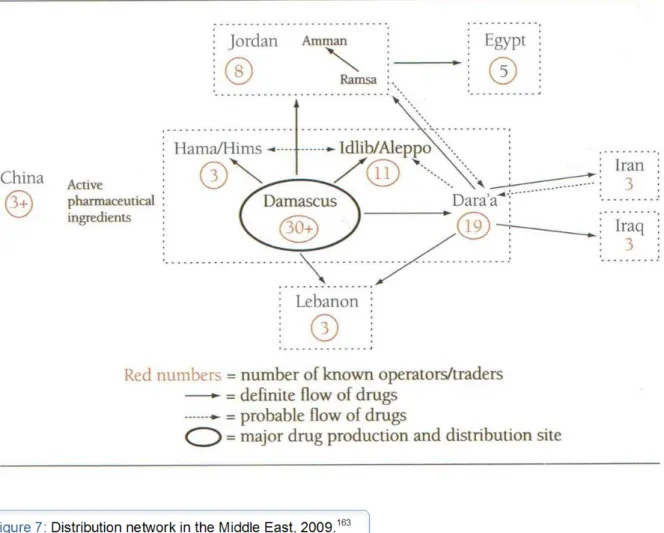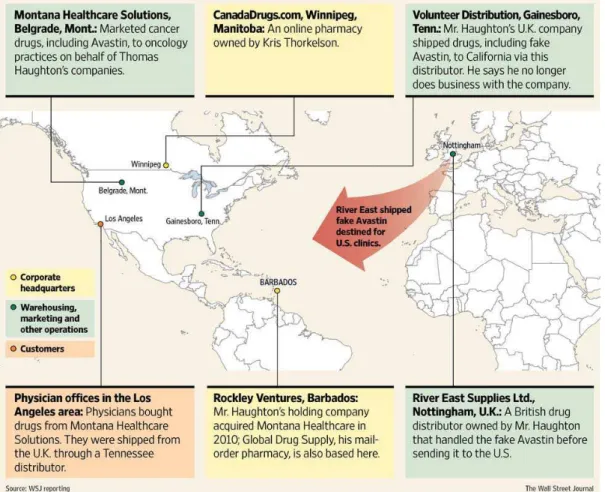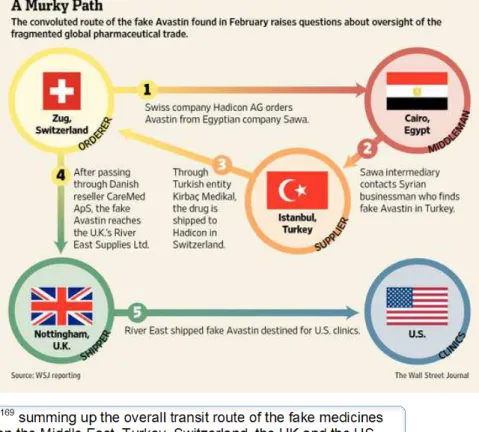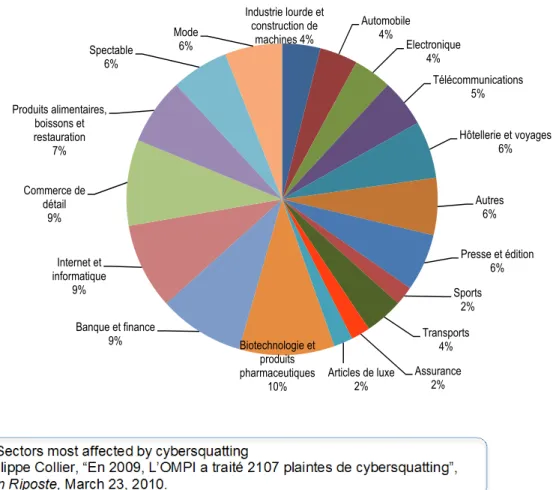HAL Id: hal-00958233
https://hal-mines-paristech.archives-ouvertes.fr/hal-00958233
Submitted on 12 Mar 2014
HAL is a multi-disciplinary open access
archive for the deposit and dissemination of
sci-entific research documents, whether they are
pub-lished or not. The documents may come from
teaching and research institutions in France or
abroad, or from public or private research centers.
L’archive ouverte pluridisciplinaire HAL, est
destinée au dépôt et à la diffusion de documents
scientifiques de niveau recherche, publiés ou non,
émanant des établissements d’enseignement et de
recherche français ou étrangers, des laboratoires
publics ou privés.
Counterfeit medicines and criminal organisations
Eric Przyswa
To cite this version:
Eric Przyswa. Counterfeit medicines and criminal organisations. [Research Report] Rapport d’étude
IRCAM : http://www.iracm.com/, IRCAM. 2013, 129 p. �hal-00958233�
Study report
COUNTERFEIT MEDICINES AND
CRIMINAL ORGANISATIONS
Report presented by IRACM
Author: Eric Przyswa
Eric Przyswa, Research Fellow Mines ParisTech in the Centre for Research on Risks and Crises, is the author of this report for the Institute of Research against Counterfeit Medicines (IRACM). The author writes in many French and foreign academic reviews (Hermès, Futuribles, Tribune de la santé, Information and Society, etc.) and conducts research on the human safety.
The report is available in its entirety on: www.iracm.com.
Institut de Recherche Anti-Contrefaçon de Médicaments 10 avenue Franklin Roosevelt
75008 Paris - France info@iracm.com
COUNTERFEIT MEDICINES
AND CRIMINAL ORGANIZATIONS
Report presented by IRACM
Author: Eric Przyswa
Table of contents
Foreword __________________________________________________________________________ 7
Introduction ________________________________________________________________________ 9
I. Medicine counterfeiting, criminal organisations and cybercrime __________________________ 11
I.1. Counterfeiting, falsification and medicines ___________________________________________ 11
I.2. State of play __________________________________________________________________ 14
In light of this assessment of counterfeit medicines, how can a more specific analysis be made of the criminal organisations involved in this ever-growing illicit trafficking? __________________________ 21
I.3. Criminal organisations and counterfeiting ____________________________________________ 21
I.3.a. Definition of criminal organisations ______________________________________________ 22
I.3.b. Criminal organisations and counterfeit medicines: a ‘structural hole’ logic ________________ 24
I.4. Cybercrime and counterfeiting ____________________________________________________ 28
I.4.a Definition __________________________________________________________________ 28
I.4.a Types of cybercrime _________________________________________________________ 29
II. Realities of the « counterfeit medicines and criminal organisations » combination __________ 33
II.1. Small-sized criminal organisations (two to five persons) ________________________________ 34
II.2. Medium-sized transnational criminal organisations (about 10 persons) _____________________ 35
II.2.a. Wuppertal case ____________________________________________________________ 35
II.2.b. Arnaud B. case ____________________________________________________________ 36
II.2.c. Peter Gillespie case _________________________________________________________ 36
II.3. Large-scale and transnational criminal organisations __________________________________ 37
II.3.a. RxNorth case ______________________________________________________________ 38
II.3.b. The ‘Jordanian-Chinese’ network ______________________________________________ 40
II.3.c. The ‘Avastin’ network _______________________________________________________ 44
II.4. Crime in China ________________________________________________________________ 47
II.4.a. Crime and exports from China ________________________________________________ 47
II.4.b. The case of mainland China __________________________________________________ 49
II.4.c. Evolution of criminal organisations in China ______________________________________ 50
II.5. Mafia groups, terrorism and financing ______________________________________________ 52
II.5.a. Mafia organisations _________________________________________________________ 52
II.5.b. Terrorism _________________________________________________________________ 55
II.5.c. Money laundering __________________________________________________________ 56
II.6. Cybercrime and counterfeit medicines ______________________________________________ 57
II.6.a. Cyberspace and criminality ___________________________________________________ 57
II.6.b. Cybercrime techniques ______________________________________________________ 58
II.6.c. Online pharmacies __________________________________________________________ 64
II.6.d. Concrete cases to illustrate the ‘cybercrime – counterfeit medicine’ combination __________ 68
II.7. A summary of the criminal organisations involved in counterfeiting medicines: organisational challenges _______________________________________________________________________ 74
II.7.a. ‘Real’ criminal networks and medicine counterfeiting _______________________________ 74
II.7.b. ‘Virtual’ criminal networks and counterfeit medicines _______________________________ 77
III. Criminological issues and recommendations _________________________________________ 83
III.1. Shaking up criminological concepts _______________________________________________ 83
III.1.a. A partially suited theoretical view ______________________________________________ 83
III.1.b. The novel nature of criminological concepts linked to medicine counterfeiting ___________ 85
III.2. Considerations to counter this phenomenon _________________________________________ 92
III.2.a. The issue of assessing the ‘crime – counterfeit medicines’ combination ________________ 92
III.2.b. Improving the analysis of the problem through centralised intelligence _________________ 94
III.2.c. The issue of law enforcement _________________________________________________ 96
III.2.d. The issue of prevention _____________________________________________________ 98
III.2.e. The importance of whistleblowers and experts __________________________________ 100
III.2.f. Internet specificities ________________________________________________________ 103
Conclusion _______________________________________________________________________ 109
APPENDICES _____________________________________________________________________ 113
Glossary of acronyms _____________________________________________________________ 114
List of interviews (in alphabetical order) _______________________________________________ 115
Bibliographic references ___________________________________________________________ 116
Foreword
Today, drug counterfeiting is a rapidly growing phenomenon in both developed and developing countries. The number of victims is rising, as is the income derived - almost with impunity - from transnational organized crime. The International Institute of Research against counterfeit Medicines (IRACM) intends to devise measures to better understand the phenomenon, educate and motivate leaders, rally public opinion, warn potential victims and to facilitate the implementation of strategies related to these issues, both from governments and the international community. This is the IRACM’s very reason for existing.
Drug counterfeiting is primarily a ‘dark figure’, and most likely a considerable one. The effectiveness and credibility of the solutions are subject to a systematic and comprehensive understanding of the phenomenon, all its aspects, its mechanisms and the strategy of organized crime, which, in many parts of world, has become a leading activity.
This is why the IRACM decided to support the creation of an in-depth study and instructed a particularly competent researcher in the field, Eric Przyswa, to conduct it.
The work he has achieved is substantial and we now know more thanks to him. He has written a very full report, which, once published, will no doubt be a milestone in the understanding of the role of organized crime in drug counterfeiting and the implications and effects of these truly transnational crimes. Transnational because they thrive in the wake of globalization by exploiting the destitution in poor countries and the credulity of the people in rich countries.
Through this report, the IRACM wishes to inform as many citizens of the world as possible of the dangers and threats it has revealed, and to ensure that policymakers take them into account to implement the necessary action, contain organized crime, protect society and safeguard the rule of law in our countries against the power these criminals have gained.
Introduction
The combat against counterfeiting started during the 1980s and, at that time, was limited to sectors where it was frequently the consumer who asked for the product, and was even party to the purchase. Above all, it is only since the start of the 2000s that the situation expanded substantially particularly with the liberalisation of the WTO1, technological developments, containerisation and the significance of China as the world's factory. On the other hand, it was only later that counterfeiting seemed to affect the pharmaceutical sector, at least from the industrial point of view. Studies and reports have covered the involvement of organised crime in ‘traditional’ counterfeiting, particularly in creative industries (luxury goods, audiovisual).
Nevertheless, even if there are more and more discussions on the topics of ‘counterfeit medicines’ and ‘organised crime’, very few researchers have analysed the relationship between the two phenomena.
Consequently, it appeared that such a report should be written and a dual objective was decided:
- To take as objective and as rigorous a view as possible on the reality of the "counterfeiting – criminal organisations" combination in the area of medicines.
- From a criminology and strategic standpoint, to give some consideration to what could be done to guide current actions.
What about the reality of this phenomenon? How can criminal organisations be characterised in our area of study? Are these organisations transnational? Is the Internet a genuine Eldorado for criminal organisations dealing in medicines?
The questions relating to our problems proved to be varied and complex. One of the interests in this research is to offer new food for thought on a potentially real, but still opaque threat for which an interpretation can only be made through a documented, pragmatic and also imaginative approach.
In the first part, the framework of our new conceptual study will be explained. It is important to define the counterfeiting and falsification of medicines in a clear field of analysis, presenting the specific features of the Internet in particular.
In the second part, we will analyse the reality of the relationship between counterfeit medicines and criminal organisations both in the physical world and on the Internet. Theoretical considerations will also supplement our own thoughts.
Thirdly, we will go into detail on the criminological issues raised by our problems. Finally, we will analyse to what extent knowledge of the phenomenon can be improved and therefore eliminated with new forms of expertise.
I. Medicine counterfeiting, criminal organisations and
cybercrime
I.1. Counterfeiting, falsification and medicines
It is essential to better determine the concepts relating to our problems so that the current challenges may be painstakingly identified.
The issue in counterfeit medicines is an old one since Dioscoride (born towards 40 A.D.), a Greek doctor and botanist, already gave advice on how to detect fake medicines2. More recently3, in post-war Vienna, counterfeit penicillin was detected in 1948, an event used in the famous film noir The Third Man, directed by Carol Reed. Etymologically, the origin of the term counterfeiting4
comes from the 18th century Latin word contrafacere which means ‘imitate’ and, generally speaking, counterfeiting is therefore a fraudulent reproduction intended to mislead the consumer on the product's real identity or origin. From a legal point of view “counterfeiting consists in the violation of an intellectual property right protected by law, particularly by reproducing by copying or imitating a design, an invention, a trademark or a model protected by an intellectual property right”5 without its owner's
consent. In the case of consumer goods, “a counterfeit is an identical reproduction or a fraudulent imitation including deception: the counterfeiter's aim is to create confusion between the original product (counterfeited) and the imitation he proposes (counterfeit). (…). Let us be clear that, in some cases, consumers are themselves fooled but they may also become a counterfeiter's accomplice by knowingly buying fakes”.6 On the other hand, it should be noted that in the case of counterfeit medicines, the patient is rather the victim and rarely the accomplice in the purchase, at best they are foolhardy enough or misled by third parties to order medicines on websites which do not have all the necessary guarantees.
Where the definition is concerned, a medicine may be defined as “any substance or compounds presented as having curative or preventive properties with regard to human diseases. Any substance or compound which may be administered to humans with a view to establishing a medical diagnosis or to restore, correct or modify physiological functions in humans is also considered as a medicine”.7 It should also be noted that a medicine is not a product like any other. To date, it is certainly the product most subject to control from its creation and its development, but also during its marketing phase (pharmacovigilance).
Similarly to other cases of counterfeiting concerning everyday consumer products, the definition of the counterfeit medicine has for many years been linked to infringement of intellectual property rights. On reflection, this analysis is all the more relevant since a counterfeit medicine involves reproducing or imitating an authentic brand and also, sometimes, copying the product patented by the pharmaceutical company. Nevertheless, however justified this may be, this view to a large degree overshadows an essential consequence of fake medicine: health.
2 Barbara Pick, Accès aux médicaments et contrefaçon pharmaceutique en Russie post-soviétique, L’Harmattan, 2006,
L’Harmattan, p. 10.
3 Albert I. Wertheimer, Perry G. Wang, Counterfeit Medicines Volume I: Policy, economics and Countermeasures, ILM
Publications, 2012, p. 1.
4 Eric Przyswa, Cybercriminalité et contrefaçon, FYP, 2010. 5 Ibidem.
6 IRACM, Fiche Propriété Intellectuelle, January 30, 2012.
7 WHO definition (WHO Drug Dictionary Enhanced) and the one in European Directive 65/65, source: IRACM, Fiche Propriété
Even though some laws have included health as a circumstance aggravating a violation of intellectual property, this parameter was only a component and not the determining element. Under these conditions, medicine counterfeiting is still closely linked to reproducing, imitating, importing and selling an intellectual property right without it's holder's authorisation. As an extension to this infringement of intellectual property rights, the terms fake, illicit, counterfeiting and counterfeit have emerged. That said, limiting the concept of medicine counterfeiting to this simple legal aspect comes down to considering this phenomenon as ordinary counterfeiting while denying its singular and dangerous nature.
The challenge in finding an exact definition of ‘counterfeit medicine’ is confirmed by Jean-Christophe Marten Pérolin, a senior official at the OCLAEPS8: “The products proposed are not always counterfeits; there are also
other forms of crime. It may mean stolen or diverted medicines, quackery or medicines which have no marketing authorisation. The process for protecting public health (and consequently consumers) is an added value in the protection of trademarks and patents. The danger to health is real and must be taken into account by all”. Gradually, the concept of falsification above all emerged and even if this concept is still relatively inaccurate in its application, falsification may be defined as the “voluntarily altering (a substance or any other elements) with a view to misleading”. Paradoxically, even if the intrinsic elements have been defined within the scope of falsification (fraudulent portrayal of its identity, of its source), counterfeiting is still the term used in numerous cases. On this subject, the most significant example is the definition deriving from the Médicrime convention, which defined falsified medicines but still kept the term counterfeiting for convenience. This semantic inaccuracy is also to be found in the definition of the IMPACT9 group's work in Hammamet (Tunisia) in December 2008.
According to the IMPACT group, whose Secretariat is provided by WHO: “A medical product is counterfeited when its identity and/or its source is falsely portrayed. This applies to the product, its packaging or to any other information concerning the packaging or labelling. Counterfeit may apply to patented products or generic products. Counterfeit products may be products containing the right ingredients/components or bad ingredients/components, no active ingredient or an insufficient quantity of the active ingredient or products whose packaging was falsified”.10 But in actual fact, in this case this is indeed the definition of a ‘falsified’ medicine.
The term falsification, compared with the term counterfeiting, by emphasising the risks of an impact on public health, makes it possible to go beyond a simple infringement of an intellectual property right. Furthermore, this concept avoids the difficult equation between the territoriality of intellectual property rights, access to medicines and the tricky issue of generics.
Preference is therefore given to the term ‘falsification’ rather than the more legal ‘counterfeiting’ to emphasise the risks of impact on public health.
In this context, the best definition would be the one in the European Directive of May 16, 201111 which defines a
falsified medicine as:
“Any medicine which falsely presents at least one of the following characteristics:
‐ its identity, including its packaging and labelling, its name or the composition, regarding any of its ingredients, including the excipients, and the dosage of these ingredients;
‐ its source, including its manufacturer, its country of manufacture, its country of origin or that of its marketing authorisation holder;
8 Philippe Collier, “L’OCLAESP cible toutes les problématiques liées à la santé publique”, Contrefaçon Riposte, December 18,
2009.
9 IMPACT: International Medicines Products Anti-counterfeiting Task force. The IMPACT Secretariat is provided by WHO. Group
without any activity at present.
10 IRACM, Fiche Propriété Intellectuelle, January 30, 2012.
11 Amending directive 2001/83/EC establishing a community code on medicines for human use with regard to preventing falsified
‐ its history, including registrations and documents concerning the distribution circuits used.
This definition does not include unintentional quality defects and is understood as being without prejudice to violations of intellectual property rights”.
This directive must be incorporated into the national legal systems of the European Union Member States by January 2013 at the latest.
Moreover, a distinction should be made between the concepts of counterfeiting and falsification in other cases: - The “sub-standard medicine” or the “non-compliant medicine”:
Even though there is no legal definition for them, sub-standard medicines (called 'OOS' -out of specification) are authentic medicines produced by manufacturers authorised by the national regulatory authority but which do not meet the quality specifications set for them by national standards for such products. The term ‘non-compliant’ means that a medicine partially deviates from the specifications set by the registration dossier approved by the registration authority and/or good manufacturing practices in force in the country of registration. It is also important to make a distinction between defective products and counterfeit medicines as, according to Médecins sans Frontières, problems with defective products are more widespread.12 The definition of a defective product is close, even identical, to that of a ‘sub-standard medicine’. There are many causes for the defect, which may include the holder of the right and its potential sub-contractors. Not conforming to the standards of quality and traceability does not constitute counterfeiting but is rather a potential consequence of this.
- “Fake medicines”:
There is no proper definition of a ‘fake medicine’. The term is occasionally employed, and is used in the Cotonou Appeal of the Jacques Chirac Foundation. A fake medicine is one that is not what it claims to be and is intended to mislead the consumer.
- “Generic medicines”:
Generic medicines are authorised copies of an original drug (brand-name drug). These copies are permitted by law once the patent protecting the active ingredient of the reference drug has expired, i.e. 20 years after the patent is filed and not 20 years after the product’s launch (sometimes there are several years between the two dates), and unless an extension is granted by an SPC (supplementary protection certificate for a maximum duration of 5 years after the initial expiry date). Even though they are not totally identical to the originals, generic drugs have the same qualitative and quantitative composition in active ingredients, the same pharmaceutical form and the same bioavailability in the body as the brand-name drug.
Generic medicines are regulated, controlled and require a marketing authorisation (MA). Accordingly, they are not a problem for public health and we should note that generic medicines can also fall victim to counterfeiting.
In short, “the problem with counterfeit medicines lies in the wider context of sub-standard pharmaceuticals. (…) Counterfeiting can apply to both brand-name and generic products and counterfeit medicines may include products with the correct active ingredients but fake packaging, or other active ingredients, no active ingredient or insufficient active ingredients”.13
In such a complex environment, the concept of counterfeit medicines must be harmonised14 as the most widely accepted definition is the previously mentioned WHO definition but this dates back to 1990. It should be updated
12 Jean-Michel Caudron et coll, “Substandard medicines in resource-poor settings: a problem that can no longer be ignored”,
Tropical Medecine and International Health, vol. 12, No. 8, August 2008, p. 1062-1072.
13 Allafrica.com, “Médicaments de qualité inférieure ou contrefaits - 25% des produits consommés dans les pays pauvres sont des
contrefaçons”, All Africa, August 25, 2006.
14 Amir Attaran, Roger Bate and Megan Kendall, “Why and How to Make an International Crime of Medicine Counterfeiting”,
as, according to this definition, counterfeit medicines involve brand-name products and generic products as well as products containing appropriate or dangerous ingredients. In this case, counterfeit products may therefore be ‘professional’ or ‘semi-professional’, even ‘amateur’.
The Council of Europe's definition is different from that of WHO in that it takes into account the counterfeiter's intentional nature in the definition and the portrayal of the counterfeit product. In this definition, it is not necessary to establish proof that the author's behaviour was actually detrimental to public and individual health. The importance of the intentional nature is to be found in the field where a distinction is rarely made between counterfeit medicines and unintentional defective medicines, and according to a report made in South-East Asia15, quality defects are more frequent (10% of medicines analysed) than counterfeits according to the WHO
definition (from 0.3 to 0.5% of medicines analysed).
As we have noted, the problem of defining counterfeiting is particularly evident in the case of medicines, particularly on an international scale. As Graham Jackson, editor of The International Journal of Clinical Practice
16
recently summarised, “among the obstacles to adopting effective measures, the lack of any clear worldwide consensus on what constitutes a counterfeit medicine, as well as the fact that activities that are illegal in one country may be legal in another”. More generally, a distinction should also be made in the analyses between the parameter on the health and public health impact and that of intellectual property17.
Consequently, particular caution is necessary in the field of statistics on counterfeit medicines and we will sparingly use the statistics given in a large number of reports, as quantifying this phenomenon on a world-wide, even regional scale, is delicate to say the least.
I.2. State of play
Counterfeiting medicines is a world-wide phenomenon, for example fake medicines for malaria and tuberculosis are present in 90 countries and kill 700,000 people each year.18 The areas most affected are Africa, Asia and Latin America. The Center for Medicines in the Public Interest19 estimates that the sale of counterfeit medicines reached USD 75 billion in 2010, i.e. an increase of 90% since 2005 while the overall turnover in the pharmaceutical sector increased from USD 605 to more than USD 856 billion in 201020. A more recent figure from the World Economic Forum21 even evaluates counterfeit medicine sales at approximately USD 200 billion, i.e. the leading sector for illicit trafficking ahead of prostitution and marijuana. Even if it proves impossible to provide reliable world-wide statistics on this situation22, it can nevertheless be estimated that the sales of counterfeit medicines over this period increased by 20% more than the legal market world-wide. In fact, it must be considered that the only sound statistical data concerns seizures made by customs.
15 Marcus M. Reidenberg, Bradley A. Conner, “Counterfeit and substandard drugs”, Clinical Pharmacology & Therapeutics, vol. 69,
No. 4, April 2001, p. 189-193 cited in Waito Foundation, Le crime-contrefaçon : Un enjeu majeur, 2011, p. 285.
16 Bulletin of the World Health Organisation, The growing threat from counterfeit medicines, vol. 88, No. 4, April 2010, p. 241-320. 17 Amir Attaran, Roger Bate and Megan Kendall, “Why and How to Make an International Crime of Medicine Counterfeiting”,
Journal of International Criminal Justice, vol. 9, No. 4, 2011, p. 947-951.
18Julian Harris, Philip Stevens, Julian Morris, “Keeping It Real - Protecting the world's poor from fake drugs”, International Policy
Network, May 2009, p. 4.
19 Ibidem.
20 Sources: IMS, Health Market Prognosis, March 2010 and Health Market Prognosis, March 2011.
21 World Economic Forum, Global Risks, Sixth edition, An Initiative of the Risk Response Network, 2011, p. 23.
22 Randall W. Lutter, Associate Commissioner for Policy and Planning, Food and Drug Administration, “Pharmaceutical Supply
Chain Security”, Statement before the Subcommittee on Criminal Justice, Drug Policy, and Human Resources, House Committee
There are three focuses on which the world-wide dimension of counterfeit medicines may be observed: the physical flows, the organisation of illicit trafficking and the Internet.
- Geography of the physical flows
According to researcher Roger Bate less than 1% of medicines are counterfeit in developed countries (United States, United Kingdom, and Europe)23 are counterfeit and approximately 10% in a large number of developing countries (Russia, China, Cambodia).
However the ‘dark figure’ is considerable and sources are limited. According to the WHO IMPACT programme:24
- one in 3 medicines is counterfeit in some African, Asian or Latin American countries, - one in 5 medicines is counterfeit in the former Soviet Union.
- China, India and, to a lesser extent, Russia remain the main producers of counterfeit medicines but Nigeria and the Philippines also have a significant number of illegal factories. 25
By geographic area26, Asia is significantly dominant by number of incidents:
Figure 1: Incidents by region.
Source: Pharmaceutical Security Institute, Situation Report, 2010.
The Pharmaceutical Security Institute (PSI) uses specific terminology where cases of counterfeit medicines are referred to as “incidents” (according to the WHO definition) but also include stolen items and illegal diversions. These statistics are submitted by pharmaceutical companies who are members of the PSI.
23 Roger Bate, Making a Killing. The Deadly Implications of Substandard and Counterfeit Drugs, Wellcome Trust presentation,
October 26, 2009.
24 IMPACT, Counterfeit medicines, Fact sheet, Estimates, November 14, 2006. It should be noted that the overall figures are
debatable.
25 See Commonwealth Business Council Working Group on Healthcare, The Problem of Counterfeit Medicines in the
Commonwealth, May 2007, p. 2.
According to its methodology, the PSI only takes into account seizures of more than one thousand medicine doses. The statistics concerning Africa are quite poor (45 incidents referenced), stemming from the inadequate means of detection and investigation in this part of the world.
In 2009, according to the PSI, Asia and Europa were the two main regions involved in manufacturing counterfeit medicines. According to the OECD, 75% of counterfeit medicines in the world come from China and India and half of these products transit through Dubai to conceal their origin.
- Organisation of illicit trafficking
This trafficking is characterised by a variety of strategies depending on the regions, the increasingly dangerous nature of the counterfeit medicines as well as an ever-greater number of seizures.
Strategies varying depending on the regions
More specifically, there are three stages in the medicine counterfeiting process: - Production:
The counterfeit medicines can be produced in an emerging country such as China but, in certain cases, in more developed countries which are happy to import for example the starting material at a lesser cost.
- Transit:
This may be by sea but air, road and rail transport may also be used or medicines even carried by travellers. The storage areas may have no relation to the country of origin, which tend to cover their tracks. Furthermore, similarly to world transport, particularly by container, goods may transit through countries, be stored in free trade zones, be transhipped to other means of transport, and in this way enable the real origin of the goods to disappear so that only their declared origin remains.
At all stages, the counterfeiters try to maximise fragmentation so as to avoid being detected (see the ‘broken load technique’ page 34).
- Distribution:
The products are often distributed through various shell companies which take advantage of local relay networks but may also be distributed directly within legal economic networks through well-known companies. In this way, they can be directly incorporated into the mainstream medicines distribution chain as far as the delivery outlet, or quite simply, in certain countries, made available on street markets or the Internet.
In industrialised countries the packaging of counterfeit medicines is identical to that of authentic medicines. The easy access to high-quality low-cost mass production printing systems is also behind an increase in internet counterfeiting. “Counterfeiters know that the key to success is making the packaging as realistic as possible, then distributing the products as quickly as they can”.27 The marketing channels are international and
counterfeiters take advantage of deregulation to penetrate a given market after passing through several countries. According to the International Federation of Pharmaceutical Manufacturers and Associations (IFPMA) counterfeiting a ‘blockbuster’ (medicine generating sales of more than one billion dollars for the pharmaceutical company) can generate a profit in the region of USD 500,000 for an initial investment of USD 1,00028 while the same initial sum invested in the trafficking of counterfeit money or heroin would bring in USD 20,000 and USD 43,000 for counterfeit cigarettes. Drug counterfeiting is 10 to 25 times more profitable than drug trafficking.29
27 Andrew Baxter, “The war on drugs copycats”, Financial Times, December 19, 2006.
28 Report written under the direction of Eric Schmidt, Evaluation de l’ampleur de la vente des produits contrefaisants sur internet,
CEIS, March 2009, p. 56.
In poor and developing countries, counterfeit medicines are of poor quality and dangerous to human health. It is very often in these countries that dangerous ingredients are found, such as the cough syrup containing anti-freeze for motor vehicles which killed 84 Nigerian children (2009). 30
In these countries, counterfeit medicines are found locally, for instance at markets or in hospitals. The counterfeit products are often also intended to treat potentially lethal illnesses, such as malaria or HIV/AIDS. These products are also copycat antibiotics, analgesics or antiparasitics.31
In Nigeria, six out of 10 medicines sold have not been approved and in Guinea, 60% of the medicines sold in pharmacies are counterfeit.32
Figure 2: Example of the manufacturing and distribution flow of counterfeit products Source: OECD, The economic impact of counterfeit and piracy, 200833
Counterfeiting is a world-wide problem. Accordingto the WCO (World Customs Organization), 140 countries are targeted. 34 Counterfeiting has become globalised.
It should be noted that information on the Chinese factories involved and their sometimes dubious methods are still not well documented. A few years ago it was estimated “that China has 80,000 firms in the chemical sector but the U.S. Food and Drug Administration does not know how many of them sell ingredients used in the medicines taken by Americans. The Times, which examined thousands of firms selling products on the major B2B sites, succeeded in identifying 1,300 Chinese firms in the chemical sector offering medical ingredients for sale”. 35
30 Blandine Fauran, “Les enjeux de la lutte contre les faux médicaments”, Cahiers de la sécurité. Les dangers de la contrefaçon,
No. 15, January-March 2011.
31 Ibidem.
32 Pierre Delval, Le marché mondial du faux. Crimes et contrefaçons, CNRS éditions, 2010, p. 153. 33 OECD, The economic impact of counterfeiting and piracy, 2008, p. 361.
34 World Customs Organization, Customs and IPR Report, 2008.
35 Walt Bogdanich, “Chinese drugs flow to market unchecked”, International Herald Tribune, November 1, 2007.
Producers Fill/Finishers Flow-through Destination
The genuinely dangerous nature of counterfeit medicines
These medicines are truly dangerous and we should remember that, even if they do not actually kill, counterfeit products, whether over-dosed, under-dosed or without any active ingredient, do not cure. Therefore, at best, a counterfeit medicine fails to cure the patient and, at worst, it is deadly. Somewhere in between, it can lead to drug resistance, which may result in treatment failure. From a more concrete standpoint, the WHO referenced a series of major accidents and particularly the case of injections of counterfeit products to treat anaemia that killed a young Argentinian woman in 2004.36
There are other examples that may be cited:
In 2006, more than 100 children in Panama were victims of a counterfeit medicine containing diethylene glycol, a powerful solvent, added to a fake cough syrup. The solvent was falsely identified and exported as glycerine, an ingredient used in a large number of medicines37.
Singapore: the health authorities recorded 11 deaths and 24 coma cases after taking counterfeit medicines for sexual dysfunction in 2008-2009.38
China: 192,000 deaths from counterfeit medicines in 2001 (400,000 deaths since 2001 according to Pharmaciens sans Frontières in Luxembourg).39
The risk to public health from counterfeit medicines is expanding: counterfeit seizures in 2009 during the ‘Storm 2’ operation, co-ordinated by IMPACT in Asia, ranged from antibiotics to contraceptives, tetanus vaccines, anti-malaria medicines and treatments for erectile problems. In Egypt, investigators have found products of all types: from medicines used in organ transplants to those prescribed for disorders such as heart disease, schizophrenia and diabetes, as well as thousands of packs of cancer medicines. 40 The PSI estimates that about 523 medicines were counterfeited in 2012.41
A growing number of seizures
According to the WCO, the trafficking of counterfeit medicines increased by 300% between 2007 and 200942. In 2009, 117 million medicines were seized by customs in Europe 43, 18 million of which were dangerous. Seizures of counterfeit medicines are becoming more and more varied.).44(anti-inflammatory drugs, pain killers,
antiseptics, medical equipment (stethoscopes, etc).
36 IMPACT, Counterfeit medicines, Fact sheet, November 14, 2006.
37 IRACM, Fiche Enjeux : Stopper une pandémie planétaire, January 30, 2012.
38 Sylvia Tan, “Counterfeit sex drugs: 11 deaths and 24 coma cases”, Friday, September 18,2009.
39 Pharmaciens-sans-frontieres.lu, “Les médicaments contrefaits”, Pharmaciens Sans Frontières Luxembourg, May 22, 2011. We
will come back to the validity of these statistics later on.
40 Comments by Aline Plançon, Interpol in the Bulletin of the World Health Organisation, vol. 38, April 2010, p. 241-320. 41 Kathy Chu, “Growing problem of fake drugs hurting patients, companies”, USA Today, September 13, 2010. 42 IRACM, Fiche Criminalité organisée, January 30, 2012.
43 Christophe Zimmerman, co-ordinator of the combat against counterfeiting and piracy at the WCO, Conférence sur la
contrefaçon à la Mutualité française : Le trafic de faux médicaments comment le combattre, October 15, 2010.
44 Interview with Jean-Christophe Marten Pérolin, senior official at OCLAESP, by Philippe Collier, “Douanes : 7 million d’articles
Between 2009 and 201045, the number of shipments intercepted by customs almost doubled: it went from 43,500
in 2009 to almost 80,000 in 2010, with health products representing respectively 18% and 14.5% of the total. These substantial figures can be explained by the huge increase in the number of illicit postal parcels intercepted, almost 50,000, which were purchases on the Internet. Germany (22,125) and Great Britain (22,146) each made almost 30% of these interceptions. In France, customs seizures mainly concern fake tablets for erectile dysfunction. That said, these figures should be put into perspective as, at the same time, it should be remembered that smaller quantities of this type of product are despatched.
In the United States, the customs authorities also seize increasing quantities of counterfeit medicines. Hence, their market value was assessed at USD 16.8 million in 2011 compared with USD 5.7 million the previous year, i.e. an increase of 200%.46 In financial terms, these medicines represent 10% of total seizures compared with 3% in 2010.47
The number of investigations conducted by the FDA (Food and Drug Administration) concerning cases of counterfeit medicines went from 6 in 2000 to 58 in 200848. Products potentially dangerous to the health and safety of consumers represented 10% of seizures made in 2008 at a value of USD 28 million. 49
There are several reasons for the increase in the number of seizures of counterfeit medicines50: - High profitability and low penal risk.
- Technological progress (particularly in printing). - Globalisation mechanisms.
Internet: a major distribution vehicle
International trans-organised crime has very quickly understood the substantial advantages that the internet has to offer. The net is decentralised and anonymous and the malleability and permanent interconnection of networks seems to offer genuine opportunities for illicit trafficking.
On the whole, e-commerce is increasing considerably world-wide and counterfeit medicines can therefore find a real growth potential in cyberspace. Even if there are still very few studies concerning the internet, a certain number of results portray the reality of the phenomenon:
- according to the WHO, 50% of the medicines are bought on web sites which conceal their physical address51,
- according to a study52 carried out by the European Alliance for Access to Safe Medicines, 62% of medicines bought on the internet are counterfeits (50% according to the WHO).
45 European Commission - Taxation and customs union, Report on EU customs, enforcement of intellectual property rights Results
at the EU border, 2010. Source: Philippe Collier, “Europe : En 2010, les douanes ont saisi pour plus d’un milliard d’euros de
contrefaçons aux frontières de l’UE”, Contrefaçon Riposte, July 15, 2011.
46 U.S. Customs and Border Protection, U.S. Immigration and Customs Enforcement, Intellectual Property Rights, Fiscal Year
2011 Seizure Statistics, 2011.
47 Ibidem.
48 Leem.org, “La contrefaçon dans les pays industrialisés”, LEEM, May 19, 2010.
http://www.leem.org/article/contrefacon-dans-les-pays-industrialises
49 Ibidem.
50 Mickaël R. Roudaut, Marchés criminels. Un acteur global, Presses Universitaires de France, 2010, p. 133.
51 Bulletin of the World Health Organisation, “Growing threat from counterfeit medicines”, vol. 88, No. 4, April 2010, p. 241-320.
- 90% of counterfeit medicines now sold on the Internet53 are fakes54 and according to a Japanese study55, 60%
of medicines treating erectile dysfunction on the Internet are counterfeits.
Some elements per geographic area - United States
In the United States, 36 million Americans56 bought medicines without a prescription on illegal sales sites and
the Internet has become the leading distribution channel for counterfeit medicines in this country.57 A more worrying statistic cited by the American firm OpSec Security58: 66% of Internet users are prepared to knowingly buy counterfeit products and 90% of people interviewed gave the price as the main criterion for buying such products. Such information challenges the claim that the patient is always the victim and not the accomplice when buying a fake medicine or, at least, is very foolhardy. Sites offering medicines for sale in America often emphasise their Canadian nationality even though there are only 300 legal Canadian on-line pharmacies. Furthermore, according to the International Chamber of Commerce, more than 11,000 fake sites using a ‘Canadian cover’ are in actual fact based in other countries (often in Russia and India).59
- Europe
The regulations adopted by the various governments to implement the new European directive vary greatly 60 from one country to another. Based on the Doc Morris61
order from the Court of Justice of the European Union (CJEU) of December 11, 2003, online marketing of products without a prescription is now authorised.
One unique study serves as a reference: the ‘Cracking Counterfeit Europe”62 study conducted in 14 European
countries concludes that the European market for counterfeit medicines is worth around EUR 10.5 billion annually. In France, the market is worth almost EUR 1 billion.
52 Agence France Presse, “Les médicaments vendus sur Internet inquiètent”, EAASM, July 2, 2008.
The study concerns the analysis of 100 on-line pharmacies and the purchase of 30 medicines.
53 Indo-Asian News Service, “Beware, 44 percent Viagra sold on net is spurious”, IANS, January 26, 2010. 54 Ibidem.
55 Pharma-japan.com, “60% of ED Treatments Sold Online Are Counterfeits”, Pharma Japan, December 21, 2010.
56 Prnewswire.com, “36 Million Americans have Bought Medications Online Without a Doctor’s Prescription”, PR Newswire,
December 14, 2010.
57 National Intellectual Property Rights Coordination Center, Intellectual Property Rights Violations: A Report on Threats to United
States Interests at Home and Abroad, November 2011, p. 31.
58 OpSec Security, Press release, OpSec Identifies High Quality and Product Functionality as Key New Drivers Motivating Online
Counterfeit Electronic Sales, July 8, 2009.
59 International Chamber of Commerce, Counterfeiting Intelligence Bureau, The International Anti-Counterfeiting Directory, 2009, p. 25.
60 Philippe Collier, “L’OCLAESP cible toutes les problématiques liées à la santé publique”, Contrefaçon Riposte, December 18,
2009.
61 The company Doc Morris offered German consumers, in German, medicine for human use, part of which were authorised in
Germany and the majority of which were authorised in other member states of the European Union. The Court held that the prohibition to sell medicines online without authorisation is justified and for those which need a prescription. On the other hand, mail-order sales of medicines that do not need a prescription and their advertising cannot be prohibited.
62 Mypharma-editions.com, “Les faux médicaments représenteraient 10,5 milliards d’euros en Europe”, MyPharma Editions,
This study, carried out by Nunwood on behalf of Pfizer Inc. shows that, in Europe, one out of five persons surveyed, i.e. 77 million individuals, acknowledges buying prescription medicines outside the authorised channels. In France, it was 14% of those interviewed, i.e. 6.9 million people.
- France
France is still safeguarded in Europe, thanks to the quality of the healthcare system, the strong regulations governing pharmaceutical activities and thanks to the system of reimbursement for prescription drugs. However, risks are now emerging in connection with “purchases of counterfeit so-called 'comfort' products on the internet, slimming pills, food supplements, performance-enhancing drugs or anabolic agents sought by bodybuilding enthusiasts”.63
Between 2001 and 2008, some 40 pharmacovigilance cases relating to the use of internet medicine purchases were reported to the Afssaps64. Out of 38 cases identified, 11 concerned purchases of slimming products, 3 anabolic steroids, and 8 stimulants or revitalizing products, particularly hormone-based.
- Switzerland
Switzerland is sometimes used as a strategic area for trafficking counterfeit medicines at European level. In 2011 the director of Swissmedic65 pointed out “a strong rise in the illegal imports of medicines potentially dangerous for patients”. According to customs authorities, seizures of illicit products rose to 61% compared to 2009. More than a third of the counterfeits were stimulants treating erectile problems.
The counterfeit medicines most frequently purchased online66 are mainly medicines against erectile dysfunction, but also slimming products, anabolic agents, growth hormones, melatonin, products to quit smoking and also narcotics and psychotropic substances.
With regard to the slimming products sold on the internet, a Swissmedic study67 showed that almost 90% contain active ingredients that are a dangerous health threat.
In light of this assessment of counterfeit medicines, how can a more specific analysis be made of the criminal organisations involved in this ever-growing illicit trafficking?
I.3. Criminal organisations and counterfeiting
The concept of criminal organisations should be determined and the logic of ‘structural holes’ used by such organisations when counterfeiting medicines.
This survey was carried out between October 27, and November 8, 2009. 14,000 men and women in 14 European countries took part in it. Countries concerned: United Kingdom, Belgium, Switzerland, Spain, Norway, Denmark, Sweden, Austria, Germany, France, Italy, Netherlands, Finland and Ireland.
63 Philippe Collier, “L’OCLAESP cible toutes les problématiques liées à la santé publique”, Contrefaçon Riposte, December 18,
2009.
64 Philippe Collier, “L’Afssaps démontre les dangers des médicaments vendus sur Internet” Contrefaçon Riposte, January 13,
2009.
65 Elisabeth Eckert, “Berne lance l'alerte contre les faux Viagra”, Le Matin, 20 F2011.
66 Blandine Fauran, “Les enjeux de la lutte contre les faux médicaments”, Cahiers de la sécurité. Les dangers de la contrefaçon,
No. 15, January-March 2011.
67 Swissmedic, Press release, Résultats d’analyse alarmants: Nouveaux chiffres sur des produits amincissants dangereux vendus
I.3.a. Definition of criminal organisations
The expression ‘organised crime’68 first appeared in 1897 in the United States and developed during prohibition. The concept is generally associated with “rackets, extortion, predatory activities and the supply of illegal goods. Interest in it revived during the 1960s with the spread of the drug dealing which grew at an unprecedented rate in the United States”.69 This view of organised crime influenced the European approach, particularly from the 1970s, with “a view of organised crime which is moving towards a more violent model, more professional and multinational”.70
There are two main definitions71 of organised crime:
- The Council of Europe (1998) describes criminal organisations as “a structured group of more than two persons, established over a period of time, acting in concert with a view to committing offences which are punishable by deprivation of freedom or a detention order of a maximum of at least four years or a more serious penalty, whether the offences are an end in themselves or a means of obtaining material benefits and, where appropriate, of improperly influencing the work of the public authorities”.
- The definition of criminal organisations with the greatest consensus is that of the United Nations Convention against Transnational Organised Crime (Palermo, December 2000)72, which defined an “organised criminal group” as a “structured group of three or more persons, existing for a period of time and acting in concert with the aim of committing one or more serious crimes in order to obtain, directly or indirectly, a financial or other material benefit”.
From a more theoretical standpoint, we note moreover that “this transition from multiple to single definition raises many questions, particularly concerning the appropriateness of the legal standard in relation to the phenomena that we wish to comprehend (…) but also (…) its purposes and its functions”.73 Consequently, a definition of
‘organised crime’ as flexible as the one decided at Palermo still raises the question of adapting the ‘legal standard’ on how organisations are perceived and treated. Another issue with the definition: the ‘transnational’ dimension. This aspect of the definition is not quite as simple as it appears and the question of relations between criminal organisations and the international economy was a subject for debate among researchers in the 1960s. It was in 1975, at the fifth United Nations congress on ‘Crime Prevention and Criminal Justice’ that the expression ‘transnational crime’74 took on its full magnitude, particularly by going into the details of the complex links which may exist between conventional organised crime, major economic actors and corrupt institutional representatives. That said, little effect seems to have resulted from this pertinent review of the situation, particularly on the type of relations in question between these actors, which has nevertheless not dampened academic debates often out of touch with the real issues.
This transnational dimension is obvious to an initial category of researchers. According to the economist Loretta Napoleoni75 “a new economy of terror has emerged” and for the journalist Claire Sterling there is a “Pax Mafiosa” with criminal organisations which peacefully share territories on a world-wide scale.76 A more ‘networked’ view of
68 We will not make a distinction between the expressions ‘criminal organisation’ and ‘organised crime’ in this report. 69 Bleuzenn Monot, La guerre de la contrefaçon. Le grand pillage des marques, Ellipses, 2008, p. 77.
70 Maria-Luisa Cesoni, Criminalité organisée : des représentations sociales aux définitions juridiques, LGDJ, 2004, p. 622. 71 IRACM, Fiche Criminalité organisée, January 30, 2012.
72 Source of the definition: United Nations Convention of November 15, 2000.
73 Maria-Luisa Cesoni, Criminalité organisée : des représentations sociales aux définitions juridiques, LGDJ, 2004, p. 5. 74 Vincenzo Ruggiero, “Fuzzy criminal actors: Introduction”, Crime, Law & Social Change, vol. 37, No. 2, p. 177-190, 2002. 75 Franck G. Madsen, Transnational Organized Crime, Routledge, 2009, p. 80.
international mafia groups77 is favoured by the sociologist Manuel Castells78, a specialist in information
technologies, who sees in these mafia organisations “a global network”. Within a more geopolitical approach, the academic Susan Strange, who considers that there “is a form of transnational mafia diplomacy which has given rise to a proliferation of informal agreements denoting the existence of an international mafia society just as a State one”.79
Another category of researchers has a more critical view and considers this transnational dimension of organised crime as ‘hypothetical’ and “to obtain additional resources or to extend their prerogatives, it is naturally of interest to the enforcement authorities to present the criminal organisations as powerful, threatening and hungry to extend their activities and influence”.80
In the context of today's globalised economy, these two views however appear to be somewhat exaggerated as we will see that, at the very least, this transnational dimension of crime is obvious. According to the most credible researchers,81 it is important to challenge the ‘conspiracy views’ as the alliances in question between so-called transnational criminal groups are above all “temporary opportunistic alliances”82 and their structures are still not particularly ‘formalised’. Criminal organisations (and ‘mafias groups’ even more so) in fact must see themselves as not particularly structured as, according to the expression of the academic, Jean-Louis Briquet 83, they are “an object with indeterminate outlines, a reality constantly avoiding the definitions suggested for them (…) a constantly changing moving phenomenon, forcing a corresponding change in the models which try to comprehend it”.
As for the ‘critical approach’, even if it raises pertinent questions on the direction in which certain enforcement agencies may or may not be going, in its analyses it neglects access to the crime sources which, even if they are difficult to access, may to a certain degree be available particularly on problems as specific as ‘counterfeit medicines’.
Generally speaking, one should avoid falling victim to sensationalism or being taken in by the frequent incorrect information on criminal organisations not only in the media but sometimes also in the academic environment.84 The whole difficulty therefore lies in having comparative research work on a study subject as complex as criminal organisations, as “although the attempt to unequivocally identify an 'organised crime' subject, enabling international comparative research to be developed, was made by various researchers85, it resulted in “an
impossibility being recognised, based on the over-diversity of the phenomena generally grouped together under these names”.86 The organised nature of the phenomenon is particularly difficult to determine.
77
There are many definitions and academic debates about the mafia. In the original sense, the term means the Sicilian mafia but in the wide sense it means any form of organised crime in other geographic areas (Russian, Japanese mafia, etc.). The mafia may be defined as a criminal organisation whose activities are subject to concealed collegial management and which is based on a strategy of infiltrating civil society and institutions. Source Wikipedia: September 15, 2012.
78Manuel Castells, End of Millennium, Oxford: Blackwell Publishers, 2000, p. 172.
79 Richard Friman, “Prise au piège de la folie ? Le pouvoir étatique et le crime organisé transnational dans l’œuvre de Susan
Strange”, Culture & Conflits, No. 42, summer 2001.
80 Gilles Favarel-Garrigues, “La criminalité organisée transnationale : un concept à enterrer ?”, L’Economie politique, No. 15, July
2002.
81 Jean-Louis Briquet or again Mark Galeotti may be cited.
82Mark Galeotti, “Introduction: Global Crime Today”, Global Crime, vol. 6, No. 1, February 2004, p. 1-7.
83 Jean-Louis Briquet, “Comprendre la mafia. L'analyse de la mafia dans l'histoire et les sciences sociales”, Politix, vol. 8, No. 30,
1995, p. 139.
84 Roderic Broadhurst, Naryanan Ganapathy, “Organized Crime in Asia: A Review of Problems and Progress”, Asian Criminology,
vol. 3, No. 1, June 2008, p. 1-12.
85 Maria-Luisa Cesoni, Criminalité organisée : des représentations sociales aux définitions juridiques, LGDJ, 2004. 86 Ibidem.
A complexity probably mainly due to globalisation, as it must not be perceived as “a technological extension”,87
particularly with the impact of the Internet, but rather as a “social process which configures and reconfigures “relations between multiple entities (…) which are widely spread over the area”.88 An interpretation which tends to prove the wide variety of social organisations present and therefore the multiplicity of potential criminal organisation models.
For all that, should it be considered that we are faced with a form of analytical stalemate?
A Council of Europe report on crime89 qualifies this stalemate and considers that “the concept of organisations with a clearly defined hierarchy seems increasingly to give way to one with criminal networks made up of individuals or small units, as well as legal structures (most often commercial) and experts of all types (lawyers, accountants, etc.) more or less closely affiliated to these structures. (…) In short, the criminal networks can function by adapting to market conditions and by exploiting the possibilities offered to them”. However, beyond this flexible organisational structure, it remains true that criminal organisations, particularly in counterfeiting, may be described as “economic extremists, who are looking for profit any way they can”.90
Although globalisation has transformed the traditional models of criminal organisations, even made them more complex, from this point of view, medicine counterfeiting is a stimulating study area which will enable us to question and shed light on ‘organised crime’ – and therefore the concepts of ‘crime’ and ‘organisation’ – under a new and pragmatic angle.
I.3.b. Criminal organisations and counterfeit medicines: a ‘structural hole’ logic
Whatever definitions of criminal organisations are accepted (Council of Europe or Palermo), the trafficking of counterfeit medicines most often meets each of the criteria common to both91:
- several persons involved,
- the existence of a real structure within the group, - the violations committed or intended are serious, - the criminal activity is stable over time.
But this view of the criminal organisation appears to be too ‘static’ as many criminal organisations, particularly where medicines are concerned, seem to be formed on ‘organisational flaws’. A point of view more particularly conceptualised by the American sociologist Ronald S. Burt92, who theorised on the concept of “structural holes”93
which appear “when there is a gap between two persons with a complementary need in terms of resources and information”.94 A third party is then necessary and acts as a sort of entrepreneur, bringing together the two
separate individuals and closing the existing gap. This ‘social bridge’ then enables the entrepreneur to make a
87 David S. Wall, Cybercrime. The Transformation of Crime in the Information Age, Polity Press, 2007, p. 37. 88 Maureen Cain, “International crime and globalisation”, Criminal Justice Matters, vol. 46, No. 1, 2001. 89 Council of Europe, Organised crime situation report: Focus on the threat of economic crime, 2005.
90 Bertrand Monnet, Philippe Véry, Les nouveaux pirates de l’entreprise : Mafias et terrorisme, CNRS éditions, 2010, p.173. 91 IRACM, Fiche Criminalité organisée, January 30, 2012.
92 Ronald S. Burt, Structural Holes. The Social Structures of Competition, Harvard University Press, 1992.
93 Ming Xia, “Organizational Formations of Organized Crime in China: perspectives from the state, markets, and networks”,
Journal of Contemporary China, vol. 17, No. 54, 2008, p. 1-23.
profit. In the field of counterfeit medicines the counterfeiters may be extremely skilful at locating the ‘social holes’ within the supply chain.
The following diagram (based on food fraud) may also be applied to crime in counterfeit medicines.
Figure 3: Criminal opportunities based on the Felson triangle.
This diagram is based on the Felson criminal triangle95 which identifies three elements offering opportunities for
crime: the criminals, the victims and the “guardians and protectors of gaps”. ‘Guardians’ should be understood as the police, customs, NGOs, etc. and by ‘protectors’ as systems intended to monitor product traceability, watch techniques, etc. Above all, the importance of the gaps and ‘structural holes’ for fraudsters is seen here. No matter how skilled the ‘guardians’ or ‘protectors’ may be in reducing the risks of counterfeit, the opportunities for crime cannot be entirely controlled and they have probably increased with globalisation and the liberalisation of international trade over the past 20 years. However, similarly to food fraud96, detecting counterfeit medicines is complicated as the counterfeiting criminals can multiply the ‘entry points’ thanks to the numerous ‘gaps’ that the logistics flows offer them.
From the more operational standpoint, it can be seen that the medicine counterfeiters use the “broken load” technique 97 which makes it difficult to seize the goods. This technique consists in “routing a counterfeit product
to its final destination and passing it through one or more third party countries which, as far as possible, are not considered to be countries producing counterfeits in that particular field. In this way, the counterfeiters hope that
95 Marcus Felson, Ronald V. Clarke, Opportunity makes the thief: practical theory for crime prevention, Police research series,
Paper 98. London: Home Office, 1998.
96 Douglas C. Moyer, John Spink, “Defining the Public Health Threat of Food”, Journal of Food Science , vol. 76, No. 9, 2011. 97 Mark Davison, Pharmaceutical Anti-Counterfeiting. Combating the Real Danger from Fake Drugs, Wiley, 2011, p. 18.
Opportunités de crimes Criminels Criminalité organisée « Gardiens et Protecteurs » des décalages Environnement criminologique Victimes
the customs will focus on where the product has come from and not its origin”.98 Furthermore, the counterfeiters
use every means of transport possible and divide up the manufacturing and packaging stages. Such operations make it difficult to trace the goods as “counterfeit medicines may be manufactured in one country, processed in another, packaged in a third before they are shipped in transit via various countries to arrive at last at the destination where they are intended for sale”.99 These criminal organisations also tend to perfect their medicines' packaging rather the content, giving priority to deceiving the customs services on the products' origin.100 On a large scale, these networks of counterfeiters also have the capacity to produce fake quality conformity certificates for the medicines or other fake official documents enabling them to infiltrate the legal wholesaler or distribution networks. Control of the distribution network is generally the key factor for the most powerful criminal organisations.101 Moreover, it can be noted that these problems of intermediation and traceability of pharmaceutical products are hardly new and that, in the 19th century, control over the products sold already gave rise to fears of counterfeiting at that time.102
This question of flows more generally poses the problem of the manufacturing and distribution network. The American system, with its complex network of distributors and wholesalers, offers a great many opportunities for a criminal organisation specialised in counterfeiting to enter into this maze of flows by identifying the weak points. As the diagram below103 shows, the three main American wholesalers which distribute 90% of medicines in the United States (AmeriSourceBergen, Cardinal Health Inc., and McKesson Corp.) are in contact with pharmacies then consumers and can also potentially be the target for the flow of counterfeit products. The risk particularly comes from 6,500 small secondary wholesalers which can be targeted by counterfeiters.104
98 Ibidem.
99 Barbara Pick, Accès aux médicaments et contrefaçon pharmaceutique en Russie post-soviétique, L’Harmattan, 2006, p. 128. 100 Roger Bate, Phake: The Deadly World of Falsified and Substandard Medicines, The AEI Press, 2012, p. 29.
101 Roger Bate, Phake: The Deadly World of Falsified and Substandard Medicines, The AEI Press, 2012, p. 146.
102 Gérard Béaur, Hubert Bonin and Claire Lemercier, Fraude, contrefaçon et contrebande de l’Antiquité à nos jours, Droz, 2007,
p. 717.
103 Wyatt Yankus, prepared for The American Council on Science and Health, Counterfeiting drugs: coming to a pharmacy near
you, updated version, 2009, p. 6.
Figure 4: Example of manufacturing and distribution flows of counterfeit products. Infiltration of U.S. Drug Supply.
As figure 4 shows, the counterfeiters seek to integrate the supply chain legally. To do this, they can mix the real and fake products and repackage counterfeit products.
The aim is to avoid arousing the suspicion of the three main American wholesalers by mixing legal and illegal products and by fragmenting the chain as much as possible thanks to secondary wholesalers who are less particular about the products' origin, making it even more difficult to trace back to the source.
Generally speaking, the United States is a priority target for counterfeiters as, according to estimates, 40% of medicines are imported there, thereby increasing the potential risk of importing counterfeit medicines. 105
These problems are also to be found in Europe, in particular in Switzerland106, which may sometimes be an intermediate zone at risk, especially due to its permeable borders with the European Union.
In fact, even if imports of medicines directly intended for the Swiss population are tightly monitored, this is less the case for exports to European countries.107 According to Hans-Beat Jenny, deputy director of Swissmedic, the Swiss Institute for therapeutic products, favourable economic and tax conditions make Switzerland an attractive country for traders in somewhat dubious medicines, and despite rather strict local practices with regard to authorisations. “That’s just the way it is”, admits the deputy director of Swissmedic. “It is often noticed that the real origin of fake medicines has been concealed”.108
105 Nabp.net, “National, International Stakeholders Develop New Strategies for Fighting Counterfeit Drugs”, NABP, May 3, 2011. 106 Julie Zaugg, “La Suisse leader des faux médicaments”, L’Hebdo, May 29, 2008.
107 Ibidem. 108 Ibidem.
